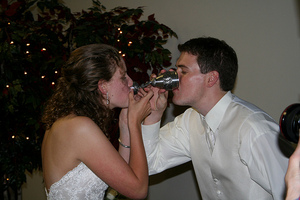German wedding traditions are some of the most interesting and fun to engage in. For the bride or groom who wants to incorporate a little of their heritage into their big day, German wedding traditions are plentiful and full of meaning.
German wedding traditions often vary from region to region, therefore, if you know what region of Germany your family hails from, you may want to incorporate certain traditions over others.
An old custom states that the father of the bride is usually in charge of all the expenses of the wedding. However, today many families share the cost. During the engagement period, both the bride and the groom wear a ring on their left hands. After the wedding, the wedding rings are worn on their right hands.
Though unusual in America, German tradition states that the bride and groom will walk to the church together. This tradition is followed by many countries, including Ireland and Italy. In Germany, the couple also walks down the aisle together.
A traditional wedding day in Germany could actually last three days. The first day would involve the bride and groom having a civil ceremony, attended only by close family and friends. The next day is equivalent to the “rehearsal dinner” and the event is attended by the couple’s family, friends, neighbors and acquaintances. A German tradition called Polterabend states that it is good luck for guests to bring old dishes to break at the event. After the dishes have all been broken, the couple must sweep up the pieces together, symbolizing that nothing in their house will ever be broken and that they can work together.
The third day is reserved for the religious marriage ceremony. A humorous tradition finds its place during the wedding. The groom may kneel on his bride’s wedding dress in order to show her who will be ‘wearing the pants’ in their marriage. However, when they stand, the bride has full right to ‘accidentally’ step on her groom’s foot to say otherwise.
Immediately after the service, a Bavarian tradition calls for the bride and groom to saw a log in half. Outside the church will be a log on a sawhorse and the bride and groom must work together to saw the log in half, symbolizing their desire to work together throughout all the trials they will face in their marriage.
After the service is the reception, where a great deal of wedding traditions take place. Often immediately after the wedding, the best man will steal the bride. While he can hide her wherever he wants, often he takes her to a pub and they drink champagne together until the groom finds them. Fortunately for the bride and best man, the groom has to pay for all the drinks they ordered.
The first dance of the evening is done by the newlyweds and is usually a waltz. Afterwards, the bride dances with her father, while the groom dances with his mother. During this, the bride’s mother may dance with the groom’s father.
A unique German custom is the creation of a “wedding newspaper.” Created by friends and family of the couple, the newspaper is filled with pictures, articles and stories about the couple. The newspaper can be given away at the reception, but traditionally, it is sold to assist with honeymoon expenses.
During the reception, the bride and groom take part in the German wedding toast, which involves a special cup, called the “Nuernberg Bridal Cup.” Often, the couple reads the story of the bridal cup to their guests in order to explain the tradition and the unusual cup.
The story is centuries old and follows the story of a noblewoman named Kunigunde. Despite her wealthy father’s disapproval, she fell in love with a young goldsmith. Kunigunde turned down suitor after suitor, no matter how wealthy they were. Her father became furious and had the young goldsmith thrown into a dark dungeon. But this did not end Kunigunde’s love for the goldsmith and she grew pale and weak at the separation from him.
Reluctantly, her father made this proposal: He told his daughter, “If your goldsmith can make a chalice from which two people can drink at the same time without spilling one single drop, I will free him and you shall become his bride.”
The young goldsmith eagerly took up the challenge and sculpted a girl “with a smile as beautiful as his own true love’s.” He hollowed out her skirt to serve as a cup. In her raised arms rested a bucket that swiveled so that it could be filled, then swung towards a second drinker.The challenge being met, the goldsmith and the nobleman’s daughter were married and the bridal cup was passed down as a symbol of love, faithfulness and good luck for whoever drinks from it.
An alternative toast is called “Who Rules the Nest?” Before the couple drinks from the bridal cup, the maid of honor stands and announces that whoever finishes first without spilling the drink will rule the nest. Because the bride has the smaller cup, naturally, she will be the winner and therefore the “ruler of the nest.” If you do want to use this toast, you may not want to let the groom in on this knowledge beforehand!
Walking Down the Aisle, Germanculture.com
German Wedding Traditions, WorldWeddingTraditions.com
German Wedding Traditions, German-Toasting-Glasses.com
The German Wedding Toast, German-Toasting-Glasses.com

